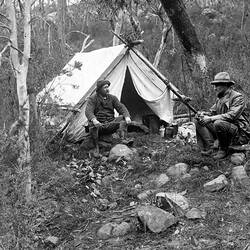WHITE-BROWED BABBLER (Pomatorhinus Superciliosus - Vigors and Horsfield - 294)
Geographical Distribution - Australia in general.
Nest - Similar to that of P. temporalis, but proportionally smaller; bulky, dome-shaped, with hooded side entrance; constructed of sticks; lined inside with such soft materials as portions of flowers, feathers, grass, bark and wool. Usually placed in a low tree or bush.
Eggs - Clutch, three to five; stout oval, texture of shell fine; surface slightly glossy; colour, lightish grey, clouded with a dark colour and usually streaked with fine hair-like lines of dark-brown or sepia. Dimensions in inches of a pair: (1) .99 x .66, (2) .95 x .67; a smaller-sized set of three: .9 x .65 inches each. (Plate 11.)
Observations - This smaller-sized Babbler has a wider distribution than the common variety, being found in both Eastern and Western Australia.
Like its larger cousin, It may be seen, even in the same locality, seven or eight in a flock hopping over the ground like rats, pulling away at the short grass or levering over lumps of bark or sticks with its beak or head. When disturbed, with spread tail and wings, these birds leap actively from branch to branch through the trees, uttering chattering noises, but not quite so loudly as the Temporal or Common Babbler.
The eggs of this species in my collection I took in the Mallee, end of October, 1884, - two nests, two or three respectively. The nests were lined with grass, fur and dry cattle manure.
Mr. James G. McDougall informs me he has taken eggs of this species in South Australia, where it is in some places called the Kangaroo Bird, early in July.
Gilbert observed in Western Australia that the breeding season commences in September, and continues during the three following months. The nest is usually constructed in a dead jam-tree (species of acacia), and it often happens that three or four pairs of birds build their nests in the same clump of trees.
Like the Temporal Babbler, the White-browed uses one of its nests as a sleeping place. At mid-winter I have witnessed a troupe filing into their dormitory at dusk.
Breeding months according to the season, from May to the end of the year.
References
Transcribed from Archibald James Campbell. Nests and Eggs of Australian Birds, including the Geographical Distribution of the Species and Popular Observations Thereon, Pawson & Brailsford, Sheffield, England, 1900, pp. 272-273.
More Information
-
Keywords
-
Authors
-
Contributors
-
Article types


